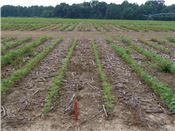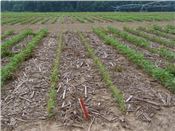Herbicide POST Application Burn On Soybean And Cotton
DR. LARRY STECKEL
JACKSON, TENN.
There have been a number of calls with concerns on how much burn soybean and cotton are showing from POST herbicide applications.
Indeed we have seen it in our research where herbicides like Flexstar, Ultra Blazer and Cobra are burning soybeans upwards of 35 percent in some cases. In cotton 20 percent or more injury from tankmixtures of Liberty or Roundup with Dual or Warrant has been common.
The long cold, cloudy and wet spell the early planted soybeans and cotton have gone through has left the cell walls in the leaves very thin and therefore more susceptible to herbicide injury. Typically the crops that have been planted in early May are at least exposed to the sun for a short period of time which causes the cell walls to thicken, also referred to as “hardening off”. These plants then have more tolerance to POST applied herbicides. Add to this, the very high humidity which makes these herbicides more active and the result is more burn.
The question is, will this POST applied herbicide injury effect yield. In soybeans I would expect good recovery and no effect on yield. In cotton where POST herbicide injury can cause a delay in maturity, the story could be different. If September is warm then the likelihood of the delay effecting yield is remote. However, if we have another cool fall then getting the top crop opened could be difficult.
Applying Dual separate from the Liberty or Roundup will greatly reduce the injury. One must consider a number of factors when making this decision including how infested the field is with Palmer amaranth, the maturity of the cotton, the planting date of the cotton and how logistically problematic it may be to come back and spray Dual a day or so after the Liberty or Roundup. ∆
DR. LARRY STECKEL: Extension Weed Specialist, University of Tennessee

Middle two rows 25% PPO burn in soybean

Middle two rows 35% PPO burn in soybean